The urethra is the tube that carries urine from the bladder out of the body. In the male dog, it passes along the back side of the dog and between the rear legs. Within the penis, the urethra lies within a trough of bone, the os penis, and becomes narrower. Calculi (stones) that develop within the urinary tract (see urinary stones) will often become stuck within the urethra behind this bone, blocking the urethra. The urethra can also be blocked if the bone is fractured or if the dog develops a tumor of the penis. Scar tissue can also cause partial blockage.
Clinical signs depend on the severity of the blockage. Dogs that have a partial obstruction may:
- urinate small amounts frequently
- take a long time urinating
- strain to urinate
- have blood in the urine
- urinate in drips instead of a strong stream
- urinate in inappropriate places (on the carpet or on their bedding)
If the urethra is completely blocked, your dog will strain without producing any urine. He/she will be in pain and be lethargic, lose their appetite, and possibly start vomiting. An overly large urinary bladder will be easily felt in the back half of the belly by a veterinary professional (Caution: it may be painful when touched). The urinary bladder may rupture and spill urine into the dog’s abdomen with complete obstruction. Dogs with total urethral obstruction will die within days if the obstruction is not relieved. Your pet should be seen by a veterinarian immediately if he/she is unable to urinate.
Urinary tract calculi are the most common cause of urethral obstruction in dogs, and anything that causes stone formation will increase the risk of urethral blockage (see urinary stones). For example, Yorkshire Terriers and Schnauzers with liver shunts (see portosystemic shunts) are susceptible to forming ammonium biurate urinary calculi. Dalmatian dogs are genetically prone to forming urate calculi. Kidney, bladder, and prostate infections can increase the risk of struvite calculi formation.
Diagnosis of obstruction is usually based on an inability to advance a urethral catheter into the bladder. Your primary care veterinarian may feel the catheter pass over the calculi in dogs that are partially obstructed. X-rays of the dog may show small stones within the bladder and/or urethra (Figures 1a, 1b, and 2). Your veterinarian may inject contrast material into a urethral catheter during x-rays to see if there is any narrowing of the urethra which may indicate a tumor or scar tissue.
Ultrasound evaluation may be recommended to assess the bladder for tumors, blood clots, stones that do not show up on X-ray, as well as to evaluate the other parts of the urinary tract (kidneys and ureters) and prostate gland in male dogs. Blood work is evaluated to determine the severity of the dog’s illness.
Kidney function may be temporarily or permanently damaged in dogs with urinary tract blockage. Potassium, which is normally removed from the body through the urine, can also be very high and can cause heart problems, so an electrocardiogram (ECG) is often performed. The urine will be checked for crystals, which may help to determine the type of stone present, and for evidence of infection, and may be submitted for culture.
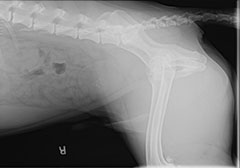
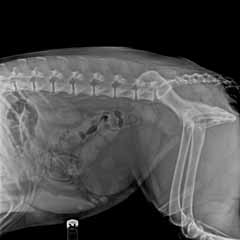
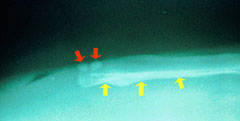
If the obstruction is caused by urinary tract calculi, your veterinarian will try to flush the stones back into the bladder, where they can either be removed surgically, dissolved with medical management (depending on the type), or broken up with lithotripsy (smashing of stones with ultrasonic waves or lasers). If your dog is very sick, surgery may be delayed, and a urinary catheter left in the urinary tract to drain urine from the bladder for a day or two, until medical conditions have improved and your pet is stable for general anesthesia and surgery.
To remove stones from the bladder surgically, a cystotomy procedure is performed. In this procedure, the dog is under general anesthesia. The bladder is accessed through a small abdominal incision. Then the bladder is opened, stones are removed, and the urinary tract is flushed thoroughly to make sure no stones are left behind. If stones in the urethra cannot be flushed into the bladder for removal, a separate incision into the urethra may be necessary. Stones removed at surgery are submitted for chemical analysis and in some cases, for bacterial culture as well. Biopsy of any abnormal bladder tissue may also be collected.
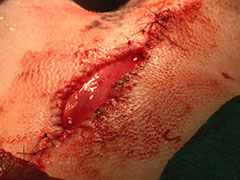
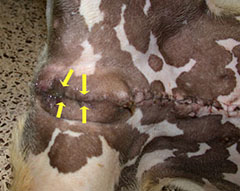
Dogs will require several weeks of restricted activity after an abdominal procedure. After cystotomy, the dog’s urinary bladder will be slightly smaller for a few weeks because of the sutures and he will likely have to urinate more often. There may be an increased sense of urgency to urinate and accidents may occur. Blood tinged urine is common (active dripping of frank blood is not normal and should prompt you to call your surgeon). The Elizabethan collar is left on for 10–14 days until the surgical site is healed to prevent licking and chewing. Your dog will likely come home with oral pain medication. If a bladder infection is present, antibiotics will be prescribed. Calculi are sent for analysis to determine whether special diets or medications are needed.
The tissue around the urethra has an excellent blood supply, and dogs may have bleeding for several days a scrotal urethrostomy. Excitement or trauma to the area from licking can increase the risk of bleeding, so dogs must wear Elizabethan collars and may require sedation for several days to reduce the chance of bleeding.
Complications of urinary obstruction include: tears in the urethra or bladder resulting in urine leakage, bladder dysfunction, incontinence, or scarring in the urethra that can cause recurrence of the obstruction. Postoperative complications after cystotomy include temporary bloody urine, urine leakage at the suture line of the bladder (uroabdomen), hernia formation at the abdominal incision, and infection.
Complications after scrotal urethrostomy include bleeding (in the first few days after surgery), irritation of the skin from urine (urine scald), scarring/narrowing of the opening that can cause obstruction, urine spraying on the legs, and infection.
Recurrence of urethral obstruction by calculi is prevented by reducing the factors that cause stone formation. If your dog is a stone former, you will need to follow your veterinarian’s diet and medication recommendations closely, and have your dog rechecked as needed to make sure crystal and stone formation is being controlled.
Prognosis is excellent for dogs that undergo cystotomy with or without scrotal urethrostomy for urethral blockage, as long as the dog has not suffered serious kidney or toxic damage from prolonged obstruction.













